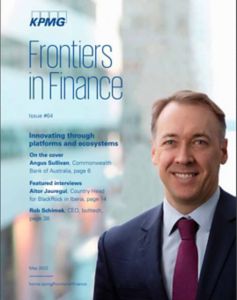This edition of Frontiers in Finance is filled with stories of financial services organizations avidly building and engaging in platforms. They are some of the leaders. They recognize that business models have changed. They understand that consumer expectations are evolving. And they see that technology is rapidly creating new revenue models and opportunities for growth.
They recognize that platforms are the lynchpin to success in this new world. They have seen that, in a platform world, integrated networks quickly become moats. And as their maturity evolves — from driving awareness to engagement to immersion to prediction — the moats they are creating around their platforms are becoming wider and value is increasing exponentially.
Perhaps most importantly, they understand that the data generated through platforms could kick off a flywheel of superior customer experiences. Simply put, financial services firms can better understand their customers (and their customers’ customers) through better customer data (transactional, contextual, behavioral and motivational, for example), thereby enabling them to anticipate and predict future customer demands. That allows them to create more products and attract more customers.
Properly targeting these new products to the right customers at the right time leads to an overall better and more valuable customer experience. Particularly when data from those experiences are fed back into the flywheel to keep the cycle going.
For those already building their platforms, the competitive gape is spreading rapidly. Leading financial services know which side of the gap they want to be on.
The right platform strategy at the right time
Every day, the moats are growing wider, and the flywheel is picking up speed. For those already building their platforms, the competitive gap is spreading rapidly. And the leading financial services firms know which side of that gap they want to be on.
What can we learn from these leaders — and those in other verticals that are achieving massive platform success? Likely the most important lesson is that platforms tend to progress through several stages, and each requires a different strategy at different points. It is key, therefore, to understand those phases and deploy the appropriate strategies at the right times.
At first, the platform will need to focus on jump-starting and growing. The idea here is to attract more customers and more producers, using that flywheel to drive better services and better experiences. With the flywheel spinning, the leading platforms then tend to start predicting what their customers and producers will want and need in the future, enabled by better data and smarter interactions.
What many platforms find is that their access to data and their growing ability to predict demand opens up opportunities in new adjacencies. At this stage, platforms often expand into new industry spaces, new product spaces and new geographic spaces (think of how Amazon used its data and models to expand from bookselling in the US to a dominant global marketplace).
In the banking space, we are seeing organizations start to focus on ‘high conviction’ themes and verticals like agriculture and food, supply chain, health and wellness, and e-commerce. They are building out their ecosystems and capabilities in their chosen areas. They are creating platforms to improve the flow of transactions and create efficiencies for participants. Then they are using their data, their ecosystem partners and their technologies to expand their value propositions into adjacencies between those customers and producers.
The Commonwealth Bank of Australia offers a good example of this in practice (they’re profiled in this publication). They started out by using their position in the home loans market to improve the way people finance and maintain their homes. Now they are using their data, their relationships, and their platform to build capabilities in green energy and ecommerce.
Delivery ‘as-a-service’
What’s the end game? We believe that, ultimately, the greatest source of growth for financial services firms will come from ‘as-a-service’ models of bank capabilities as well as finance. Several financial services firms are already there. Consider, for example, how Blackrock (also profiled in this publication) is packaging up its data to provide clients with ‘risk-analytics-as-a-service’. Goldman Sachs’ reinvent program is essentially providing ‘regulated-cloud-as-a-service’. HSBC is exploring how they can use their daily liquidity reporting to provide other banks with ‘liquidity-data-as-a-service’.
The leading financial institutions are also moving into embedded finance, providing ‘as-a-service’ solutions to corporate clients across a number of different service layers. They are providing the digital wallets, transaction banking products and e-commerce solutions that underpin seamless customer journeys andexperiences. They are supporting product provision with supply chain finance, consumer finance and circular economy services. They are providing data services, with insights gleaned from their supply chain software and financial services tools. And they are providing infrastructure such as lending-as-a-service. They are both enabling others’ platforms, as well as creating platforms themselves.
Seeing it in action
The global restaurant franchise chain, McDonalds, offers an illustrative example of the size of the prize. McDonalds serves 60 million customers a day. It has 34,000 franchise outlets. It spends around US$9 billion per year across its supply chain. And its corporate offices spend around US$21 billion per year on wholly-owned outlets and other costs. By providing a banking-as-a-service platform, banks could be reinventing themselves by playing to their core strengths and embedding finance in those existing transactions.
Leading financial institutions are providing the digital wallets, transaction banking products and e-commerce solutions that underpin seamless customer journeys and experiences.
On the consumer side, financial institutions could be providing the loyalty benefits programs and the personalization. To franchisees they could be offering lending-as-a-service, (i.e. when purchasing goods from corporate) as well as business advisory services and employee services. They could also be providing lending-as-a-service to the supply chain, alongside risk services like cash, currency, resilience and so on. At the corporate office level, they could be offering corporate treasury and liquidity, as well as franchise health services, for example. The opportunities are immense.
We have also seen a global supermarket chain drive that transformation from the corporate side. What started as a program to create synergies across its seven businesses led to the creation of a common data platform. That platform was then opened up to fintech partners, third parties and digital product managers to encourage the development of new digital products and services — essentially commercializing their existing data through software as a service. That has led to better customer experiences, new products and services, and a greater share of wallet around simple financial services products like lending, insurance, payments and wallets. It has also unlocked incremental revenues.
The skills and speed to get there
Regardless of what financial service you might provide through an ‘as-a-service’ model, speed to market is critical. The majority of efforts that we have seen tend to be incubated away from the core organization, often through venture environments to be a separate business of the financial institution. These provide the kind of enabling structures that ‘newco’ type models require to grow quickly — IP commercialization strategies, balance sheet velocity, data sharing, streamlined global, risk and compliance (GRC) processes and new ways of working, for example.
Our view also suggests there are four characteristics shared by those leading the move towards ‘as-a-service’ models. They tend to have strong commercialization capabilities in terms of business development, pre-sales and partnerships. They create high performance architecture with common data models, open data standards and strong meta-data management. They build low-cost operating models using modern extensible architecture and leveraging highly automated infrastructure-as-a-service. And they strive to attract and retain people with the right skills and experience.
Don’t be left behind
As financial services firms strive to create their platforms and form their ecosystems, they should be building with the end game in mind. Our view suggests that the future lies in delivering value to customers through ‘as-a-service’ models. And the time for staking out your position in those future markets is rapidly shrinking as the gap between the leaders and the deniers widens.
Our advice to financial services leaders is to move quickly, but with a clear vision of where you want to play and how you plan to get there. The last thing you will want is to be left behind.
Connect with us
- Find office locations kpmg.findOfficeLocations
- kpmg.emailUs
- Social media @ KPMG kpmg.socialMedia
Stay up to date with what matters to you
Gain access to personalized content based on your interests by signing up today






